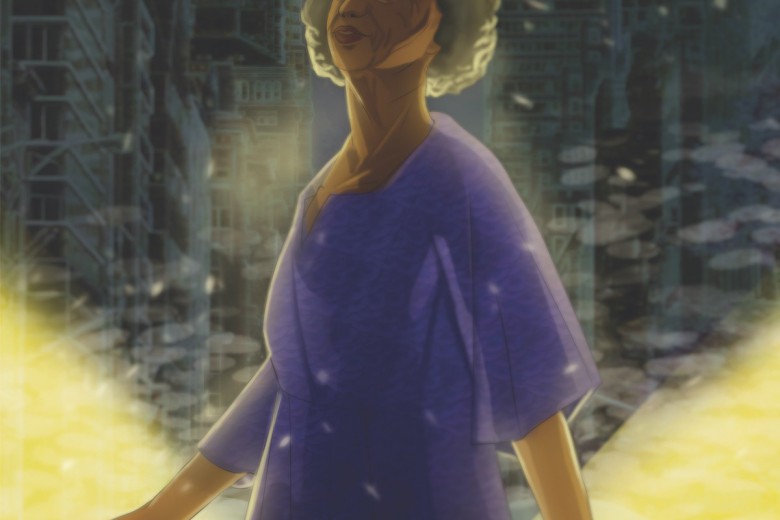It’s taken about a year for our tenants’ group in Winnipeg, Manitoba – on Treaty 1 territory – to take a few wobbly steps forward as a cohesive unit. The housing coordinator for the West Broadway Community Organization has been coaching us in the tedious and dry policies of the Residential Tenancies Act, but at times the group has felt stagnant and frail. The problems facing us low-income tenants, in our slowly gentrifying community on the border of downtown, seem overwhelming at times: rent hikes, predatory landlords, and buildings in disrepair. But our first event, “Politics and Popsicles: Policing and Gentrification in West Broadway,” packed the room full of new faces, with multiple people sitting on the floor because all the chairs had been filled.
One of our speakers was Owen Toews, a member of the Bar None prison visiting rideshare, post-doctoral fellow at the University of Alberta, and author of Stolen City: Racial Capitalism and the Making of Winnipeg. He opened a discussion about the forces shaping Winnipeg, our neighbourhood, and the lives of everyone in the room. It was energizing, brought in a few new committee members, and built confidence in our group’s capacity.
At the time of writing, our committee is trying to shame Armour Property Management into compensating victims of illegitimate – and, we believe, likely illegal – renovictions, where landlords evict tenants so they can renovate apartments and apply for above-guideline rent increases. Many of those displaced are older Indigenous women. But beyond helping tenants navigate bureaucratic nightmares, what can we do to address the root cause of these evictions?
This is the context in which I began to read Stolen City: building up my knowledge of Winnipeg’s history and politics to better understand the conditions of our organizing. These illegal evictions are just a new form of settler-colonial displacement of Indigenous peoples in Winnipeg.
Stolen City explores the evolution of “dominant blocs” of capitalist coalitions in Winnipeg, and how these blocs have shaped the city for their own profit. The dominant blocs took different forms: in the days of the Hudson’s Bay Company, merchants put down the Red River Resistance; industrialists brought in the military to shut down the 1919 General Strike; and as Winnipeg’s industrial boom ended in the 1930s, developers leveraged state subsidies to expand suburban communities instead. The suburbs were amalgamated into the city of Winnipeg and city council was stacked with suburban voters, siphoning public resources away from the inner city. Today, developers are clamouring to “revitalize” the inner city – which means displacing its poor and racialized residents through gentrification, in an attempt to draw corporate investment.
This history details how capitalist structures “renew, renovate, and entrench” racism to justify their plunder, and transfer land, wealth, and resources from one racial group to another.
While the term “stolen land” is usually used to talk about the history of Indigenous dispossession under colonialism, “stolen city” brings that theft into the present. The reader confronts futures that were denied, as Indigenous plans for decolonized urban development were buried and sidelined through the efforts of these dominant blocs. This history details how capitalist structures “renew, renovate, and entrench” racism to justify their plunder, and transfer land, wealth, and resources from one racial group to another.
Indigenous peoples are incompatible with the dominant blocs’ visions for the future, and thus are presented as in need of dispossession and “management” by white settlers. But Toews explains how in 1971, a group called the Manitoba Indian Brotherhood (now the Assembly of Manitoba Chiefs) put forward an urban development plan called Wahbung: Our Tomorrows, which envisioned a city based on Indigenous traditions and values. This document was developed in response to the federal Liberals’ White Paper and while Winnipeg developers were settling the suburbs.
Wahbung called for land redistribution, and Indigenous-owned housing, hospitals, and schools – defying the settler-colonial narrative that Indigenous peoples were incapable of self-determination. These racist ideas, amplified by settler journalists, paved the way for the systemic abandonment of the inner city by developers – but documents like Wahbung preserve a decolonized history of resistance. Organizing to shape the city they wanted to inhabit helped build the strength of urban Indigenous activism in Winnipeg – which burst forth in the Red Power movement of the ’60s and ’70s, and carries on today.
Toews is a white settler, born and raised in Winnipeg, descended from Russian Mennonites. Throughout Stolen City, he writes in first person about his experiences conducting interviews and doing research. By doing so, he acknowledges that the process of writing this book was not a passive, impartial act of research and observation, but an active and political project of shaping and interpreting narratives. He does so with the goal of using Winnipeg’s history to fuel community action today.
I appreciate how Stolen City exposes the very tangible manifestations of settler colonialism in the form of housing, railroads, and shopping centres – especially because settler colonialism usually attempts to naturalize and hide its own workings. Toews asks: whom does this infrastructure benefit? Who is being displaced? And he addresses my own question: where do I – a white settler – even begin, when it comes to a project as vast as reshaping a city for poor and Indigenous residents?
Right now, it’s helping evicted tenants file Residential Tenancies Branch claims forms. But Stolen City makes it clear that we do not have to stop there. If we have the will, we can build on the legacy of others who imagined and fought for decolonized urban development.
As the dominant blocs evolve their forms and agendas, so too must community organizing. In documenting these evolutions, and preserving stories of resistance, Stolen City is more than a book – it is an act of community service.






_780_520_90_s_c1.jpg)
